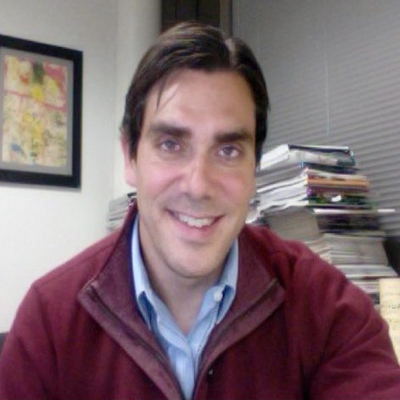Studying the biological brain for the purpose of engineering
The human brain is one of the most impressively designed biological systems. The ideas of conscience, self-awareness, and learning in unique ways are novel to our brain, and have been enviously studied by designers of engineered systems. Dr. Gabriel Silva, Professor and Vice Chair of the Department of Bioengineering at the University of California, San Diego, is pushing the boundaries of our understanding of the brain and how it works by developing algorithms and models that explain its function mathematically. In order to understand how the brain works normally, and what fails in disease states, within a dynamic system that is constantly changing, like the brain, mathematics and experimental data must be used. Dr. Silva is taking fundamental mathematical data to design models that explain how the brain works and processes information. The models allow Dr. Silva to understand the brain as a complex system, and to make predictions about how it works normally and fails in disease. Further, if he is able to understand the algorithms that govern how the brain represents, processes, and computes information, he may be able to apply them to neuromimetic engineered systems and computational architecture with no relation to the biological brain. This would allow the incorporation of properties unique to the human brain into artificial systems, including robustness, our ability to learn and be trained on a small data set, the ability to adapt and learn beyond that small data set, autonomy - or our ability to make decisions on our own, the ability to carry out high-level computations at physically low power requirements, and real-time adaptability - the ability of an algorithm to change its own governing rules to improve efficiency in response to real-time learning. These are all properties that the biological human brain completes with ease, but which have proven extremely difficult to replicate in artificial systems. This research has applications in improving computing ability and artificial intelligence, but also has very real human applications in its ability to cure neurological disease and alleviate neurological-related complications. Studying the human brain from a mathematical and bioengineering perspective is giving us mastery over our greatest biological challenge.
Dr. Silva is interested in theoretical and computational neuroscience aimed at understanding how the structure and geometry of neurobiological networks constrain and determine information flow within the brain. An emerging application of this work is the development of neuromimetic (i.e. neural imitating) algorithms, which are based on a mathematical understanding of the rules by which the biological brain computes. This research is multi-scale in time and space, meaning different mathematical algorithms are used for different purposes across a hierarchy of structures in the brain. Dr. Silva is relying on experimental data, both data which he collects as well as data found in the literature, to create mathematical models that describe brain function. These models are educated guesses that explain the relationships between measured biological data and a specific parameter of interest. Essentially, Dr. Silva is explaining what is occurring in the brain using mathematical language, and testing his explanations using his models. His research begins with a foundational model grounded in experimental data which he uses to prove theorems that describe properties of the brain, similar in practice to a mathematician. He is also interested in neuroengineering applications at the interface between nanotechnology and neuroscience, in particular nanoelectronic technologies for the stimulation and recording of neural activity (EEG) and the restoration of neural function. The more detail Dr. Silva is able to extract, the better he will understand the brain and the mathematical rules guiding it, which will grant him more freedom to extract away from biology, and apply his newfound data to computers and engineered systems.
Current research projects are related to understanding the brain mathematically and extracting that data for use in biomedically and electrically engineered systems:
-
Related to the computational side of his research, Dr. Silva is understanding the brain by learning about the computational rules the brain uses to compute information, and taking those rules to build new algorithms and apply those algorithms to different functions. This multidisciplinary approach combines aspects of mathematics, engineering, neuroscience, and computer science and engineering at the scale of biological neural networks. Given the information currently known about individual neurons (function, properties, etc.), Dr. Silva is studying how these neurons link up to form neural circuits in a way that allows him to understand and predict emergent properties of neural networks. Neural network emergent properties are those that the collective network exhibits that go beyond the capabilities of individual neurons. Studying this requires the formation of mathematical models, and testing those models using computer simulations, to confirm whether or not the models exhibit emergent-type properties.
-
A practical, multi-lab project is developing a nanoengineered retinal prosthesis using optoelectronic nanowires. This is a nanochip that is surgically planted in the back of the eye, local to the retina, which replaces the function of degenerates photoreceptor neurons, which take light and convert it into a chemical signal the brain can interpret and use to “see.” The chip uses nanofabricated wires in an array, which are sensitive to light, to electrically stimulate the remaining neurons in the retina. Degenerated photoreceptor neurons are the leading cause of blindness in older individuals in the Western world, and any chance at restoring vision is a project with monumental implications.
- Astrocyte glial cells are the second major cell type in the brain after neurons. The classical belief of astrocytes was that their role was homeostatic, meaning they were identified as being responsible for maintaining the environment that ensures that neurons survive, i.e. removing waste products and maintaining the proper chemical environment so that the highly-excitable neurons are not improperly triggered. As Dr. Silva’s research has revealed, astrocytes have all the molecular machinery necessary for cross-talking with neuronal networks, being able to “listen in to neurons” as they communicate with one another and respond to those neurons. Astrocytes themselves form huge networks of their own in critical areas of the brain. In the hippocampus, a region related to memory formation and processing, astrocytes outnumber neurons ten to one! Dr. Silva is interested in understanding why the molecular machinery for communications with neurons are present in astrocytes, and how this communication occurs. He is studying astrocyte neurobiology from a computational perspective using models based in mathematics and engineering to understand what astrocyte cells are doing to modulate and contribute to neuronal information processing.
Bio
Dr. Silva has always had a fascination with the brain and the way it handles complex processing. In particular, he is fascinated with the dynamic aspects of the brain and its emergent properties, such as consciousness and self awareness. The idea that the brain as a whole has vastly expanded abilities in its entirety, as compared to its parts, is one that drives him to study the brain as a whole. In the practical approach of his research, Dr. Silva is also very interested in neurological disorders, and what happens within the brain when its parts malfunction.
When questioned about the steps that led him to pursue a career as a Neuroscientist, Dr. Silva admits that it is really the only career he has wanted to do - he has had clear directives all along. His driving consideration is wanting to understand the factors that make us human, but which are still beyond the reach of our understanding. What does it mean to be self aware, for example? What is it about our brain that allows for this phenomenal property?
When he is able to escape the lab, Dr. Silva mainly finds himself exploring the outdoors, from backpacking and hiking through the backcountry to surfing and diving in San Diego’s pristine Pacific environment. He is also a contributor to emergency wilderness medicine.
Publications
Awards
Career Milestone Award, 2014
Presented by the University of California, San Diego
Biocom Cell Art Exhibit winning entry: “SEM of cortical neurons on optoelectronics nanowires,” 2014
‘Faculty of the Year’ award for undergraduate education, 2012
Presented by Tau Beta Pi Engineering Honors Society
Jacobs Faculty Fellows Chair in Bioengineering, 2009-2014
Selection to “Nanoscience: The best of NATURE publications,” 2009
Y.C. Fung Young Investigator Award, 2008
Presented by the American Society of Mechanical Engineers (ASME)


